checking oil KIA Optima 2016 4.G Owner's Manual
[x] Cancel search | Manufacturer: KIA, Model Year: 2016, Model line: Optima, Model: KIA Optima 2016 4.GPages: 623, PDF Size: 15.4 MB
Page 500 of 623
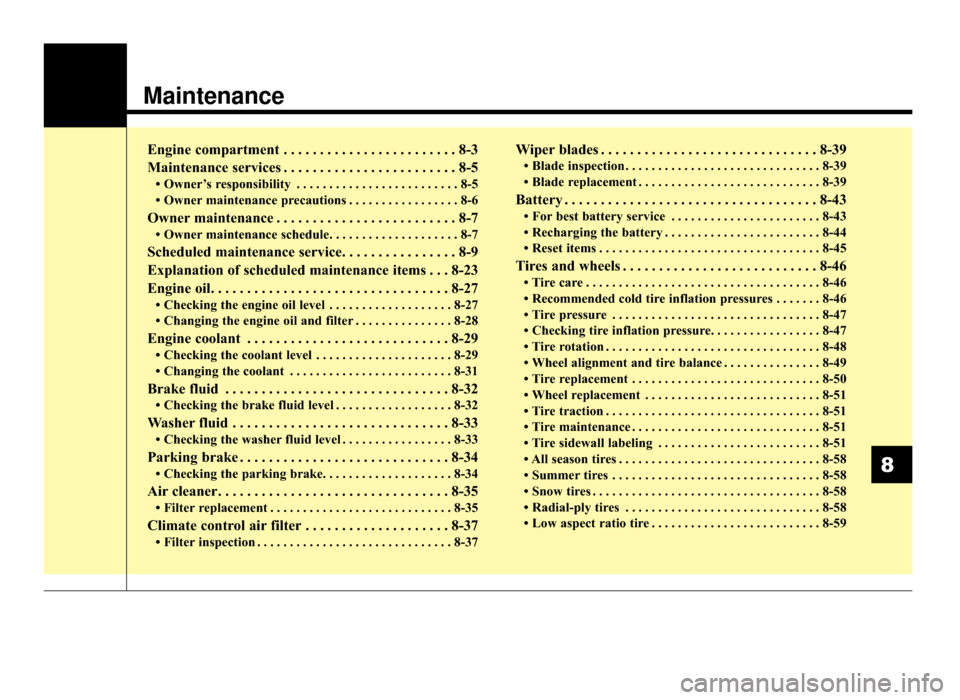
Maintenance
Engine compartment . . . . . . . . . . . . . . . . . . . . . . . . 8-3
Maintenance services . . . . . . . . . . . . . . . . . . . . . . . . 8-5
• Owner’s responsibility . . . . . . . . . . . . . . . . . . . . . . . . . 8-5
• Owner maintenance precautions . . . . . . . . . . . . . . . . . 8-6
Owner maintenance . . . . . . . . . . . . . . . . . . . . . . . . . 8-7
• Owner maintenance schedule. . . . . . . . . . . . . . . . . . . . 8-7
Scheduled maintenance service. . . . . . . . . . . . . . . . 8-9
Explanation of scheduled maintenance items . . . 8-23
Engine oil. . . . . . . . . . . . . . . . . . . . . . . . . . . . . . . . . 8-27
• Checking the engine oil level . . . . . . . . . . . . . . . . . . . 8-27
• Changing the engine oil and filter . . . . . . . . . . . . . . . 8-28
Engine coolant . . . . . . . . . . . . . . . . . . . . . . . . . . . . 8-29
• Checking the coolant level . . . . . . . . . . . . . . . . . . . . . 8-29
• Changing the coolant . . . . . . . . . . . . . . . . . . . . . . . . . 8-31
Brake fluid . . . . . . . . . . . . . . . . . . . . . . . . . . . . . . . 8-32
• Checking the brake fluid level . . . . . . . . . . . . . . . . . . 8-32
Washer fluid . . . . . . . . . . . . . . . . . . . . . . . . . . . . . . 8-33
• Checking the washer fluid level . . . . . . . . . . . . . . . . . 8-33
Parking brake . . . . . . . . . . . . . . . . . . . . . . . . . . . . . 8-34
• Checking the parking brake. . . . . . . . . . . . . . . . . . . . 8-34
Air cleaner. . . . . . . . . . . . . . . . . . . . . . . . . . . . . . . . 8-35
• Filter replacement . . . . . . . . . . . . . . . . . . . . . . . . . . . . 8-35
Climate control air filter . . . . . . . . . . . . . . . . . . . . 8-37
• Filter inspection . . . . . . . . . . . . . . . . . . . . . . . . . . . . . . 8-37
Wiper blades . . . . . . . . . . . . . . . . . . . . . . . . . . . . . . 8-39
• Blade inspection . . . . . . . . . . . . . . . . . . . . . . . . . . . . . . 8-39
• Blade replacement . . . . . . . . . . . . . . . . . . . . . . . . . . . . 8-39
Battery . . . . . . . . . . . . . . . . . . . . . . . . . . . . . . . . . . . 8-\
43
• For best battery service . . . . . . . . . . . . . . . . . . . . . . . 8-43
• Recharging the battery . . . . . . . . . . . . . . . . . . . . . . . . 8-44
• Reset items . . . . . . . . . . . . . . . . . . . . . . . . . . . . . . . . . . 8-45\
Tires and wheels . . . . . . . . . . . . . . . . . . . . . . . . . . . 8-46
• Tire care . . . . . . . . . . . . . . . . . . . . . . . . . . . . . . . . . . . . \
8-46
• Recommended cold tire inflation pressures . . . . . . . 8-46
• Tire pressure . . . . . . . . . . . . . . . . . . . . . . . . . . . . . . . . 8-47
• Checking tire inflation pressure. . . . . . . . . . . . . . . . . 8-47
• Tire rotation . . . . . . . . . . . . . . . . . . . . . . . . . . . . . . . . . 8-48
• Wheel alignment and tire balance . . . . . . . . . . . . . . . 8-49
• Tire replacement . . . . . . . . . . . . . . . . . . . . . . . . . . . . . 8-50
• Wheel replacement . . . . . . . . . . . . . . . . . . . . . . . . . . . 8-51
• Tire traction . . . . . . . . . . . . . . . . . . . . . . . . . . . . . . . . . 8-51
• Tire maintenance . . . . . . . . . . . . . . . . . . . . . . . . . . . . . 8-51
• Tire sidewall labeling . . . . . . . . . . . . . . . . . . . . . . . . . 8-51
• All season tires . . . . . . . . . . . . . . . . . . . . . . . . . . . . . . . 8-58
• Summer tires . . . . . . . . . . . . . . . . . . . . . . . . . . . . . . . . 8-58
• Snow tires . . . . . . . . . . . . . . . . . . . . . . . . . . . . . . . . . . . 8-\
58
• Radial-ply tires . . . . . . . . . . . . . . . . . . . . . . . . . . . . . . 8-58
• Low aspect ratio tire . . . . . . . . . . . . . . . . . . . . . . . . . . 8-59
8
JF CAN (ENG) 8.qxp 11/5/2015 6:40 PM Page 1
Page 506 of 623
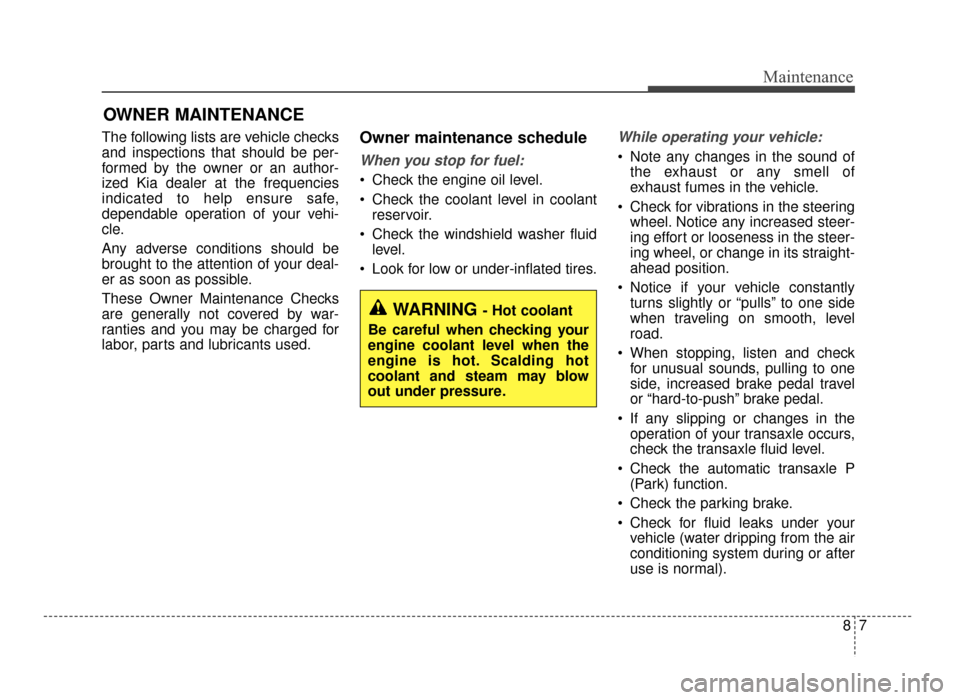
87
Maintenance
OWNER MAINTENANCE
The following lists are vehicle checks
and inspections that should be per-
formed by the owner or an author-
ized Kia dealer at the frequencies
indicated to help ensure safe,
dependable operation of your vehi-
cle.
Any adverse conditions should be
brought to the attention of your deal-
er as soon as possible.
These Owner Maintenance Checks
are generally not covered by war-
ranties and you may be charged for
labor, parts and lubricants used.Owner maintenance schedule
When you stop for fuel:
Check the engine oil level.
Check the coolant level in coolantreservoir.
Check the windshield washer fluid level.
Look for low or under-inflated tires.
While operating your vehicle:
Note any changes in the sound of the exhaust or any smell of
exhaust fumes in the vehicle.
Check for vibrations in the steering wheel. Notice any increased steer-
ing effort or looseness in the steer-
ing wheel, or change in its straight-
ahead position.
Notice if your vehicle constantly turns slightly or “pulls” to one side
when traveling on smooth, level
road.
When stopping, listen and check for unusual sounds, pulling to one
side, increased brake pedal travel
or “hard-to-push” brake pedal.
If any slipping or changes in the operation of your transaxle occurs,
check the transaxle fluid level.
Check the automatic transaxle P (Park) function.
Check the parking brake.
Check for fluid leaks under your vehicle (water dripping from the air
conditioning system during or after
use is normal).
WARNING - Hot coolant
Be careful when checking your
engine coolant level when the
engine is hot. Scalding hot
coolant and steam may blow
out under pressure.
JF CAN (ENG) 8.qxp 11/5/2015 6:40 PM Page 7
Page 526 of 623
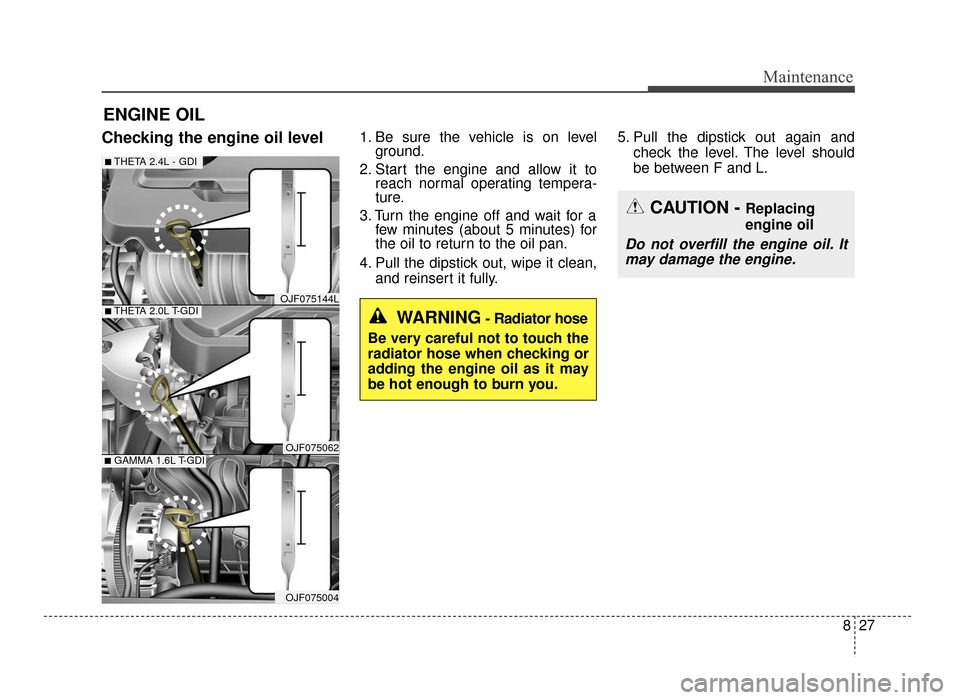
827
Maintenance
ENGINE OIL
Checking the engine oil level1. Be sure the vehicle is on levelground.
2. Start the engine and allow it to reach normal operating tempera-
ture.
3. Turn the engine off and wait for a few minutes (about 5 minutes) for
the oil to return to the oil pan.
4. Pull the dipstick out, wipe it clean, and reinsert it fully. 5. Pull the dipstick out again and
check the level. The level should
be between F and L.
CAUTION - Replacing
engine oil
Do not overfill the engine oil. Itmay damage the engine.
■THETA 2.0L T-GDI
■THETA 2.4L - GDI
OJF075062■GAMMA 1.6L T-GDI
OJF075004
OJF075144L
WARNING- Radiator hose
Be very careful not to touch the
radiator hose when checking or
adding the engine oil as it may
be hot enough to burn you.
JF CAN (ENG) 8.qxp 11/5/2015 6:40 PM Page 27
Page 531 of 623
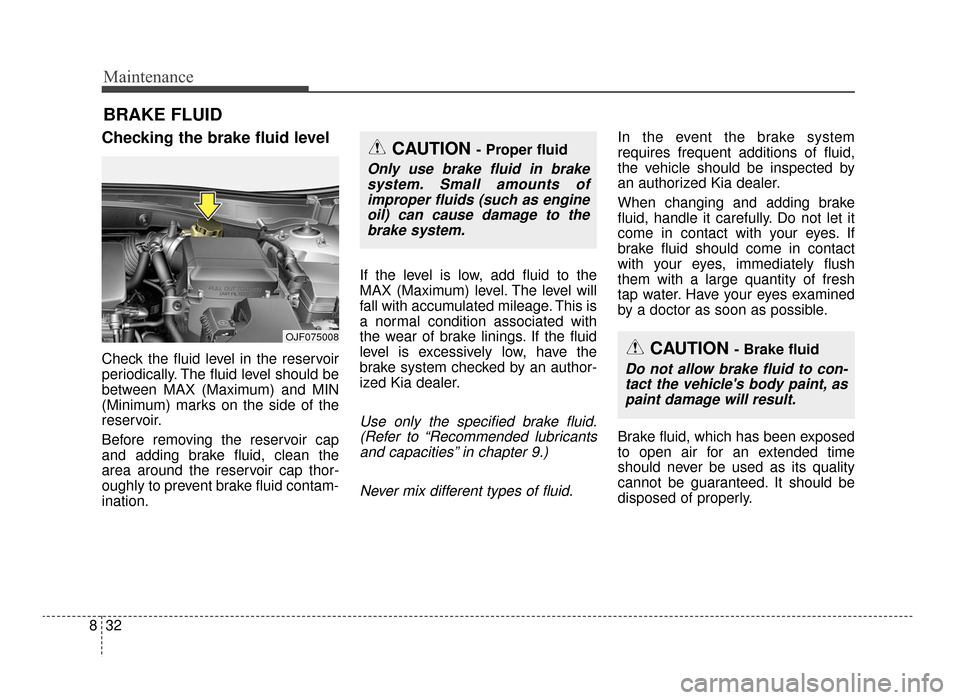
Maintenance
32
8
BRAKE FLUID
Checking the brake fluid level
Check the fluid level in the reservoir
periodically. The fluid level should be
between MAX (Maximum) and MIN
(Minimum) marks on the side of the
reservoir.
Before removing the reservoir cap
and adding brake fluid, clean the
area around the reservoir cap thor-
oughly to prevent brake fluid contam-
ination. If the level is low, add fluid to the
MAX (Maximum) level. The level will
fall with accumulated mileage. This is
a normal condition associated with
the wear of brake linings. If the fluid
level is excessively low, have the
brake system checked by an author-
ized Kia dealer.
Use only the specified brake fluid.
(Refer to “Recommended lubricantsand capacities” in chapter 9.)
Never mix different types of fluid.
In the event the brake system
requires frequent additions of fluid,
the vehicle should be inspected by
an authorized Kia dealer.
When changing and adding brake
fluid, handle it carefully. Do not let it
come in contact with your eyes. If
brake fluid should come in contact
with your eyes, immediately flush
them with a large quantity of fresh
tap water. Have your eyes examined
by a doctor as soon as possible.
Brake fluid, which has been exposed
to open air for an extended time
should never be used as its quality
cannot be guaranteed. It should be
disposed of properly.
OJF075008CAUTION - Brake fluid
Do not allow brake fluid to con-tact the vehicle's body paint, aspaint damage will result.
CAUTION - Proper fluid
Only use brake fluid in brakesystem. Small amounts ofimproper fluids (such as engineoil) can cause damage to thebrake system.
JF CAN (ENG) 8.qxp 11/5/2015 6:40 PM Page 32
Page 610 of 623
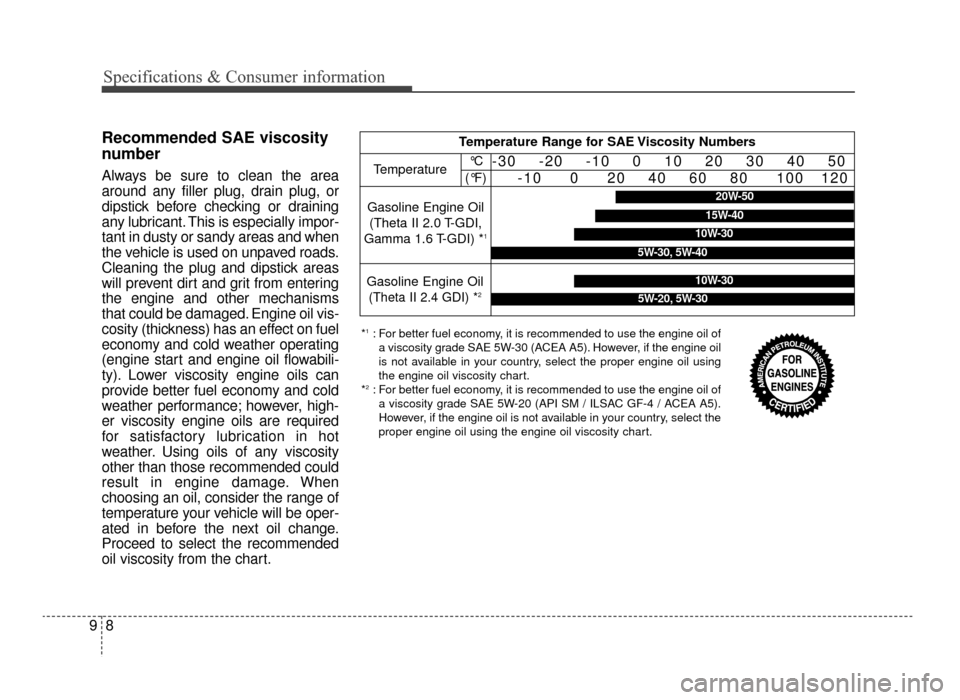
Specifications & Consumer information
89
Recommended SAE viscosity
number
Always be sure to clean the area
around any filler plug, drain plug, or
dipstick before checking or draining
any lubricant. This is especially impor-
tant in dusty or sandy areas and when
the vehicle is used on unpaved roads.
Cleaning the plug and dipstick areas
will prevent dirt and grit from entering
the engine and other mechanisms
that could be damaged. Engine oil vis-
cosity (thickness) has an effect on fuel
economy and cold weather operating
(engine start and engine oil flowabili-
ty). Lower viscosity engine oils can
provide better fuel economy and cold
weather performance; however, high-
er viscosity engine oils are required
for satisfactory lubrication in hot
weather. Using oils of any viscosity
other than those recommended could
result in engine damage. When
choosing an oil, consider the range of
temperature your vehicle will be oper-
ated in before the next oil change.
Proceed to select the recommended
oil viscosity from the chart.
Temperature Range for SAE Viscosity Numbers
Temperature°C
(°F)-30 -20 -10 0 10 20 30 40 50 -10 0 20 40 60 80 100 120
Gasoline Engine Oil
(Theta II 2.0 T-GDI,
Gamma 1.6 T-GDI) *
1
20W-50
10W-30
15W-40
5W-30, 5W-40
*1: For better fuel economy, it is recommended to use the engine oil of a viscosity grade SAE 5W-30 (ACEA A5). However, if the engine oil
is not available in your country, select the proper engine oil using
the engine oil viscosity chart.
*
2: For better fuel economy, it is recommended to use the engine oil of a viscosity grade SAE 5W-20 (API SM / ILSAC GF-4 / ACEA A5).
However, if the engine oil is not available in your country, select the
proper engine oil using the engine oil viscosity chart.
Gasoline Engine Oil(
Theta II 2.4 GDI) *210W-30
5W-20, 5W-30
JF CAN (ENG) 9.qxp 11/5/2015 4:31 PM Page 8
Page 617 of 623
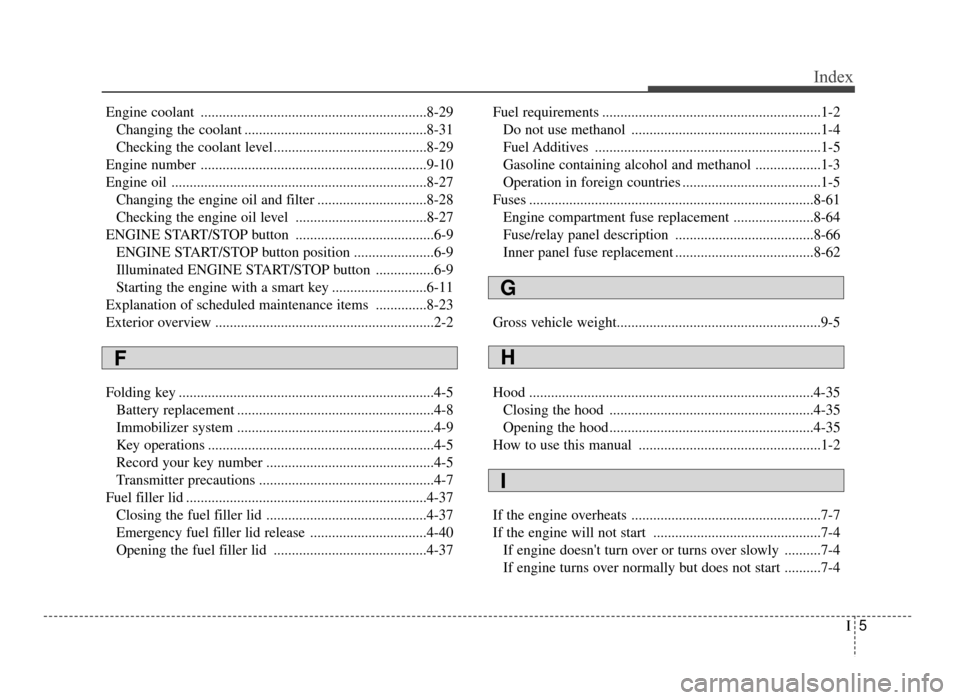
I5
Index
Engine coolant ..............................................................8-29Changing the coolant ..................................................8-31
Checking the coolant level..........................................8-29
Engine number ..............................................................9-10
Engine oil ......................................................................8-\
27 Changing the engine oil and filter ..............................8-28
Checking the engine oil level ....................................8-27
ENGINE START/STOP button ......................................6-9 ENGINE START/STOP button position ......................6-9
Illuminated ENGINE START/STOP button ................6-9
Starting the engine with a smart key ..........................6-11
Explanation of scheduled maintenance items ..............8-23
Exterior overview ............................................................2-2
Folding key ......................................................................4-\
5 Battery replacement ......................................................4-8
Immobilizer system ......................................................4-9
Key operations ..............................................................4-5
Record your key number ..............................................4-5
Transmitter precautions ................................................4-7
Fuel filler lid ..................................................................4-37 Closing the fuel filler lid ............................................4-37
Emergency fuel filler lid release ................................4-40
Opening the fuel filler lid ..........................................4-37 Fuel requirements ............................................................1-2
Do not use methanol ....................................................1-4
Fuel Additives ..............................................................1-5
Gasoline containing alcohol and methanol ..................1-3
Operation in foreign countries ......................................1-5
Fuses ........................................................................\
......8-61 Engine compartment fuse replacement ......................8-64
Fuse/relay panel description ......................................8-66
Inner panel fuse replacement ......................................8-62
Gross vehicle weight........................................................9-5\
Hood ........................................................................\
......4-35 Closing the hood ........................................................4-35
Opening the hood ........................................................4-35
How to use this manual ..................................................1-2
If the engine overheats ....................................................7-7
If the engine will not start ..............................................7-4 If engine doesn't turn over or turns over slowly ..........7-4
If engine turns over normally but does not start ..........7-4
FH
G
I
JF CAN (ENG) Index.qxp 9/23/2015 4:32 PM Page 5